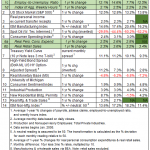Consumer Spending Myth
It is widely believed that consumer spending accounts for approximately two-thirds of the economy. A few of us dispute that claim.
Reader Gary writes “You had made the comment more than once that manufacturing is really a much larger part of GDP than is frequently quoted. I could not find how you got there, but ZeroHedge has a nice Pie Chart that shows what you have stated.“
It’s Only a Manufacturing Recession
The chart Gary referenced is from “But It’s Only A Manufacturing Recession, What’s The Big Deal” – Here’s The Answer.

I am not sure of the origin of that chart, or its precise accuracy, but the essential idea rings true.
GDP Illusion
In Is the US Economy Close to a Bust, Pater Tenebrarum at the Acting Man Blog points out …
One thing that we cannot stress often enough is that the manufacturing sector is far more important to the economy than its contribution to GDP would suggest. Since GDP fails to count all business spending on intermediate goods, it simply ignores the bulk of the economy’s production structure. However, this is precisely the part of the economy where the most activity actually takes place. The reality becomes clear when looking at gross output per industry: consumer spending at most amounts to 35-40% of economic activity. Manufacturing is in fact the largest sector of the economy in terms of output.
In The GDP Illusion Tenebrarum writes …
Sure enough, in GDP accounting, consumption is the largest component. However, this is (luckily) far from the economic reality. Naturally, it is not possible to consume oneself to prosperity. The ability to consume more is the result of growing prosperity, not its cause. But this is the kind of deranged economic reasoning that is par for the course for today: let’s put the cart before the horse!
In addition to what Tenebrarum states, please note that government transfer payments including Medicaid, Medicare, disability payments, and SNAP (previously called food stamps), all contribute to GDP.
Nothing is “produced” by those transfer payments. They are not even funded. As a result, national debt rises every year. And that debt adds to GDP.
Real GDP is constantly overstated because it’s obscured by a cloud that hides monetary inflation and ignores both debt and bubbles.













Leave A Comment